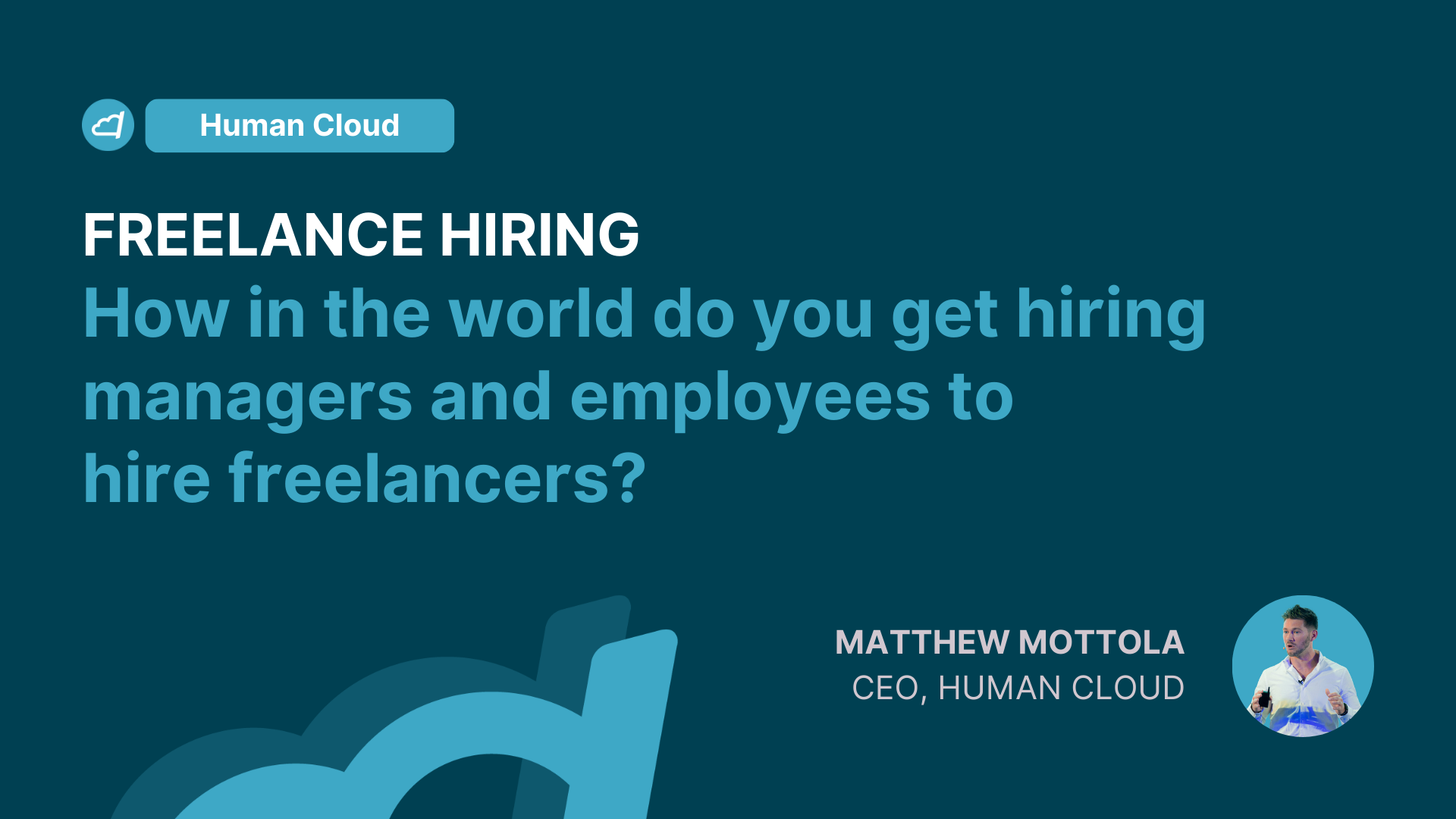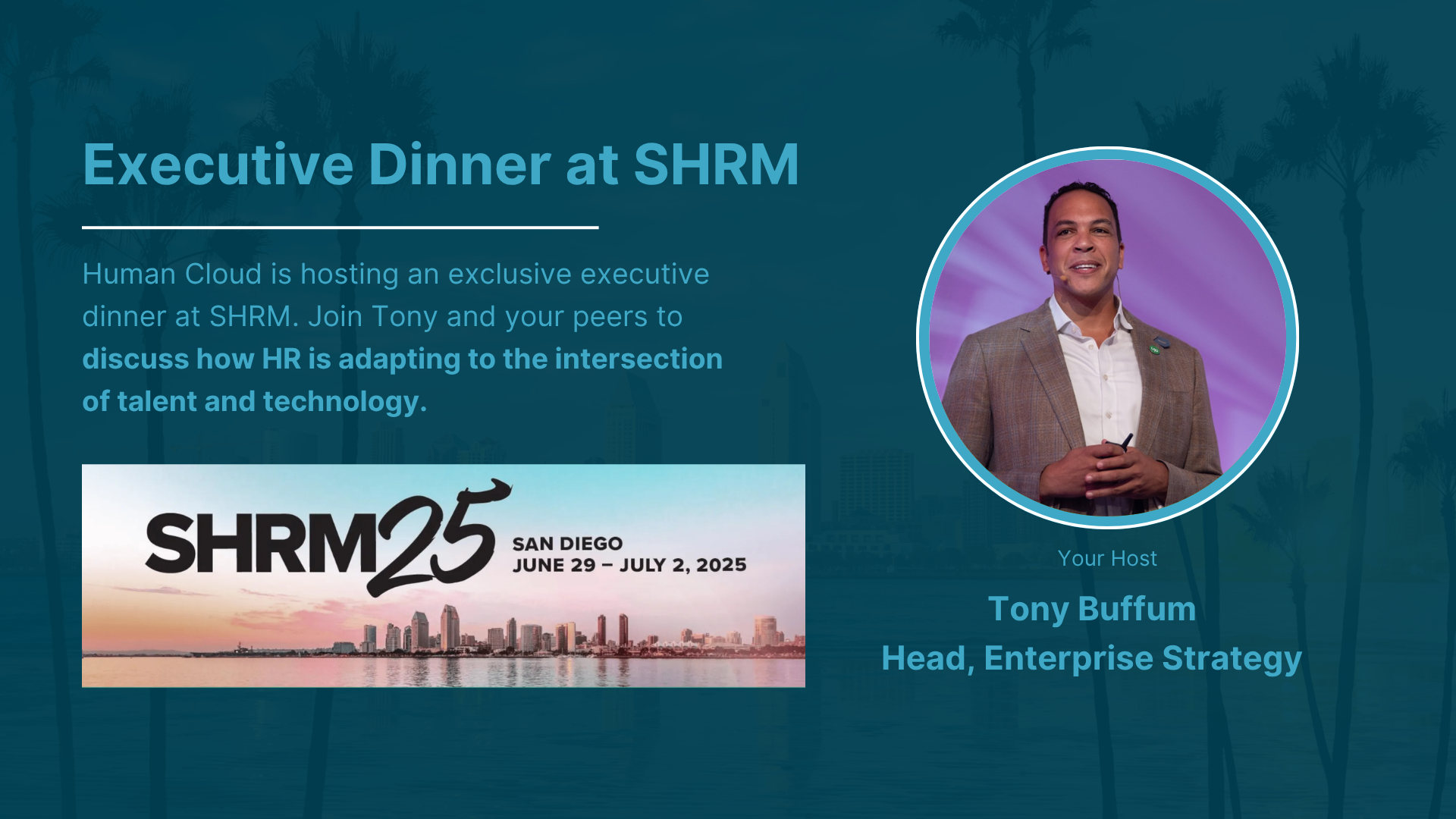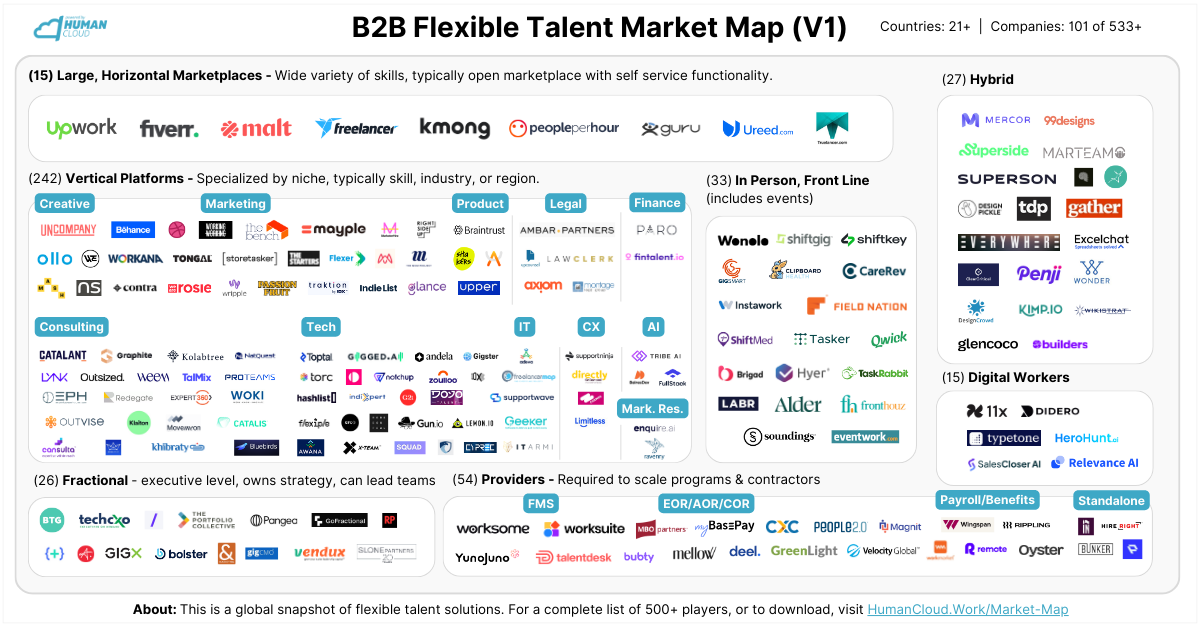
Freelance Hiring: How to get hiring managers and employees started hiring freelancers

Human Cloud Team
Share this!
Subscribe to Human Cloud Insights
This article is for leaders evangelizing freelance across your company, or platform leaders scaling freelance experiences that convert and expand across accounts. Enjoy!
Question: What’s the leading activity for hiring managers to hire a freelancer? Is it a catchy ad? A trendy influencer? An outbound email? Your new ChatGPT job posting tool? A webinar?
Answer: None of the above, it’s feeling FOMO from a colleague and asking to copy exactly what they did. Depending on the platform, it can be as basic and as “rogue” as extending the hours on the existing contract to account for two hiring managers but still under one contract.
Obviously, this has dire consequences for the company and the platform.
For the company, there’s now high legal and compliance risk, along with an inability to accurately track the experience and ensure a good freelancer and employee experience. You also join the over half of companies that freelancers say don’t know how to work with freelancers.
For the platform, you’ve now risked your exposing your client to this risk and removed visibility of the hiring manager experience.
But it’s not uncommon. In fact, hiring manager conversion from interest to hire is poor across most freelance experiences (between 5-25% for most first time hiring managers), and I’d argue is one of the biggest weaknesses freelance platforms and programs have in driving adoption.
The Main Takeaway: Every Enterprise is hiring freelancers, but most spend is “rogue”, happening outside of approved channels
What do the best do?
They replicate what hiring managers are used to. Rather than expecting hiring managers to use their platform, or fill out paperwork like they’re at the doctor, they deliver the uniqueness of freelance (speed, hyper-relevant skills, low risk freelance contracts) with the normalness of existing hiring or contingent talent experiences.
Karina Rehavia of ollo.is calls this “high tech with high touch”. EPH – expertpowerhouse shows this through their freelancer delivery deck.
EPH presentation example
What should you do? In this article I’ll teach you how to get hiring managers adopting freelance at scale.
What to expect…
The science behind hiring manager conversion using Microsoft and Human Cloud data
A 3 step process for increasing conversion
A template you can download
The Main Takeaway: The best freelance experiences replicate what hiring managers are used to, and bring the best of freelance to them without expecting high effort or learning something new
Disclaimer: When I say hiring freelancers in this article, I am referring to the bottom up approach of hiring managers hiring freelancers, the top down approach of leadership signing off budgets for freelancers, and both the individual hiring of freelancers and bulk buying of outcomes done by freelancers (it is increasingly common for freelance agencies on freelance platforms to lead adoption).
Why is conversion from interest to hire so low?
Microsoft’s findings
There is little public data on this, but the best report to date is Microsoft’s report Stuck in the middle with you: The transaction costs of corporate employees hiring freelancers.
In it, they highlight 3 key challenges.
There is a strong power law of usage. They say, “Prior work [17, 23] has shown that on-demand economy platforms are characterized by a few requesters who are responsible for posting the overwhelming majority of the work.”
There is high management overhead, specifically added overhead compared to existing staffing solutions internally or externally. They say, “Working with freelancers had different overhead than working with contract workers hired from a staffing agency or with other employees. They had to select the freelancers themselves which they did not normally do with contract workers as the staffing agency usually did that. In order to vet freelancers, they often had to examine their portfolios and see who they had worked with—they tended to look for freelancers who had already worked with their company or similar companies.” They cite a specific example, “P31 said she received “a few hundred emails from the [redacted] platform” and that it was overwhelming. However, with contract work, she would have worked with one person and that person would have managed the 10 translators for her.”
Companies, hiring managers, and platforms have conflicting requirements and goals. They say, “The burden of negotiating between corporate fealty, platform requirements, and responsibility to freelancers are transaction costs that fall on individual employees“.
The Main Takeaway: It’s too much of a hassle, and only those with extreme pain (the power users) stick with it
Our Own Findings
We consistently see three main problems across all platforms and enterprises.
Hiring managers aren’t hiring managers. Most likely, nowhere in their job description is “hiring freelancers” listed. Nor are there any incentives to hire a freelancer.
Nobody likes the process of hiring, and the perception of hiring freelancers is that you go through all that work, only to do it again in a week when the freelancer is on to their next gig. This perception is far from the reality. Freelancers don’t do gigs, they stay working with who they like, and the hiring process should be nothing like the typical HR hiring process. The hiring process should be quick (less than a minute to create/scope), low effort (not needing to know all the requirements), low risk (worse that happens is you find a new freelancer after a month), and high reward (potential to work forever with top talent). But…that’s the perception.
Basic change management. People don’t want to change, and without restructuring incentives, creating an easy process, and basic change management principles like social proof, hiring managers rightfully resist a decision that can seem like a hot potato.
The Main Takeaway: A lack of infrastructure, incentives, and normalization create a large change management challenge
What should you do with this data? How can you increase conversion?
To recap; in getting hiring managers to hire, there are two massive forces in your way, (1) freelance hiring is too much of a hassle, and only those with extreme pain (the power users) stick with it, and (2) a lack of freelance infrastructure, incentives, and normalization create a large change management challenge.
So what should you do?
You need to combine three things
Mindset – how do you view the hiring manager relationship?
Process – what steps do you consistently do for each new hiring manager?
Technology – what tools/app/platform do you use to input, deliver, and iterate on the hiring process?
Mindset
In order to meet a hiring managers need, you need to deeply understand them beyond their freelance interest.
To start, remember…THEY DON’T WANT TO HIRE FREELANCERS. They want to get their work done. They want access to expertise. They want a more efficient way to grow their teams and their org.
Also remember…they could care less about our industry jargon. Time to hire, talent pools, direct sourcing, fractional, etc, they really don’t care about our terms, they simply care about how we can solve their pain.
Here are 4 steps to always keep in mind when you meet a new hiring manager.
Step 1: Start with their business goals
We all have metrics or business goals that keep us up at night.
What are they? How are they currently solving them? Why isn’t full time hiring or doing nothing not working anymore?
You might have to tell them 1-3 business cases that freelance has solved for to establish credibility and get them to open up (clients check out your aggregated business cases in your portal).
Next, ask the source of accomplishing, or not accomplishing these goals. Ask questions like:
What’s not getting done because you don’t have the right talent?
What’s getting shipped but not working because you don’t have the right expertise?
What skills do you need? Or types of people you need?
**Keep your questions open ended, it’s about them talking, not creating the perfect job description.
Step 2: Understand their existing process
We aren’t their first talent rodeo.
What do they currently do? Do they pick up the phone and call their HR or Procurement lead?
Every enterprise already has a robust external talent ecosystem with internal contingent talent offices and armies of MSP’s, agencies, and approved vendors.
Rather than add something new for them, see how you can make freelance as similar to what they’re already used to.
Step 3: Understand their fears
This might get them fired. It’s a less than 1% probability, but rather than ignoring it, understand the risk that they’re taking by not following the “no one gets fired by hiring Accenture” reality.
Step 4: Think small
Great, they’re interested, but how do they get started? Show them something that seems like low hanging fruit with large potential impact.
For example, Cyril Foin of Malt uncovered that a client needed “a cyber security expert based in Ireland that’s ready now”. That’s something low risk (most solutions haven’t worked), yet very high impact. What is the equivalent in your model?
The Main Takeaway: Start by understanding hiring managers deeper than their freelance interest, then uncover a quick and low risk way for them to get started.
Process
Keep it simple! I’m proposing 3 steps below, but it might be as simple as a hiring manager writing down a couple sentences on a napkin, or giving you a call in between meetings.
In a perfect world, your process should be as short, and as simple, as you need to gather the relevant data to source the first round of freelancer(s) within 2-5 days.
Step 1: Convert the pain into a spec
What does the hiring manager really need? It’s up to you to go from problem to prescribing the needed scope. The better the platform, the more they can turn descriptions of problems into the right solution.
For example, with Maari Casey of Uncompany, we sent a CEO to them at 7:03 am on a Monday with the exact email “PPT deck, 15-20 slides, public facing, mostly polishing”. She met with the client before 10 am, the freelancer was working by 5 pm, and the client was delighted with a deck that could be used with no changes by Thursday. That is the gold standard for converting a problem into a solution. They didn’t say “post the project”, or “what skills do you need”, or “how many hours is this project”, they simply converted the problem into what the client needed, a public facing designed PPT deck.
A book that really helped early in my career was The Challenger Sale. It combined sales and consulting in a way that most of us have to be for hiring managers. Not too consulting or they’ll fall asleep. Not too sales or they won’t trust you and will get annoyed.
Also, this is where specialized platforms really shine.
Step 2: Qualify the work
Make sure the work is ideal for freelance. At this point 90% of work is ideal for freelance, but there still are red flags.
For example…
Is this the first time the hiring manager is hiring for this role?
Does this look like a full time role handed down to you? For example, 40 hrs/week, multiple responsibilities with vague ways to measure these responsibilities? 2-6 page job description?
Is this high, high risk, and it’s the hiring managers first time?
Is there a comparable for what success looks like?
Step 3: Document
The beauty of a talent platform is that the platform can document and store important data to source the next freelancer, or help hiring managers across the company.
Document everything.
Document the types of candidates that hiring manager, hiring managers team, hiring managers org, and company as a whole likes.
Document the needed onboarding files. Is there a brand kit? Or a team charter? Or guidelines?
Document the weird cultural quirks.
As much as people will tell you it’s AI, it’s most likely an account manager with notes and a good CRM system.
The Main Takeaway: Keep it simple…convert problems into freelancers working, qualify to ensure it’s a fit, and document everything
Level 3: Technology
Here’s a secret. No hiring manager is logging into your platform.
Here’s another secret. Most times paper and pizza do the trick.
Below is a template that we use to get hiring managers started. Here are a couple of ideas to use it.
Always have printouts of this template.
Give evangelists printouts of this template to help them help their team.
Host lunch and learns with pizza as the reward for filling out the template.
Bring this with you to all your meetings, talks, and maybe even happy hours.
Always have snacks in your office, and always offer snacks and help to hiring managers .
Find growth and innovation related events at your company. Are there hackathons? Bring this and offer to help!
You tell me! What other creative ideas do you have?
More From Human Cloud

SHRM Executive Dinner
Join Tony Buffum and your HR executive peers at SHRM for a closed door dinner to discuss HR, TA, and the intersection of talent and technology.

Talent Innovator Index
Talent Innovator Index: Are You A Leader Or Lagger? We developed a quick way to measure you or your clients level of talent innovation. Each leader gets a score, and that score determines which persona you fit in below.

Market Map
Human Cloud’s Market Map is a global snapshot of the B2B Flexible Talent Industry. The Flexible Talent Industry encompasses fractional, freelance, and gig talent platforms, along with the increasing agentic AI applications to digital workers.

 This is only available to Knowledge Graph subscribers
This is only available to Knowledge Graph subscribers 